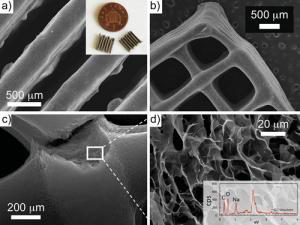Researchers at the Centre for Advanced Structural Ceramics at Imperial College London (ICL) cooperated with teams from the University of Warwick, the University of Bath, and the Universidad de Santiago de Compostela to use graphene oxide (GO) and reduced graphene oxide (rGO) together with small amounts of a responsive polymer (a polymer that changes upon activation of a 'chemical switch'), to formulate water based ink or pastes for 3D printing applications.

The scientists say that their formulations sport the required flow and physical properties for 3D printing (namely, the ability to flow through miniature nozzles but set immediately after that), for a technique called direct ink writing (DIW), robocasting or direct write assembly (DWA). This technique is based on the continuous deposition of a filament following a computer design.
The produced inks allow printing through nozzles as thin as 100 µm and their rheology could also be tailored for other processing technologies such as extrusion, gel, or tape casting. The researchers' goal was to print graphene structures (not composites) using small amounts of additives and water-based systems, in a way that it could be scaled up in a manufacturing process. Due to graphene's hydrophobia it is not possible to formulate a water-based ink directly so the scientists used GO (which can be processed in water).
Once a structure is made, it is thermally treated in a special atmosphere to recover the properties of graphene. Among the potential applications for this process are flexible electronics and oil adsorption.
Source: nanowerk